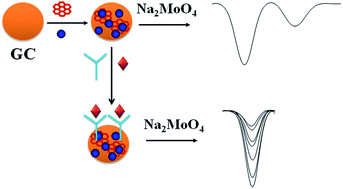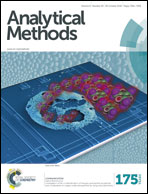A label-free electrochemical immunosensor for the detection of cancer biomarker α-fetoprotein (AFP) based on hydroxyapatite induced redox current
Abstract
A sensitive and selective electrochemical immunosensor for label-free detection of cancer biomarker α-fetoprotein (AFP) was developed based on hydroxyapatite (HAP) nanoparticles induced electrochemical current. HAP nanoparticles and graphene oxide (GO) were co-immobilized onto an electrode surface to modify the electrode. The phosphate groups contained in the HAP nanoparticles can react with molybdate to form redox molybdophosphate precipitates on the electrode surface, generating electrochemical current. GO enhanced the electrochemical current intensity due to its good conductivity. The following immobilization of the anti-AFP antibody and capture of AFP resulted in the formation of an immuno-complex layer on the electrode. This immuno-complex layer prevented the reaction of hydroxyapatite nanoparticles with molybdate, leading to the decrease of the electrochemical current, and the current change is proportional to the concentration of AFP detected. A wide linear range (0.01–10 ng mL−1) and low detection limit (5 pg mL−1) towards AFP detection were obtained. The reliability of the proposed immunosensor was evaluated by the detection of AFP in human serum samples. This study demonstrated the potential of the developed immunosensor in ultrasensitive detection of AFP or other biomarkers.


 Please wait while we load your content...
Please wait while we load your content...